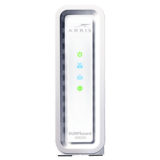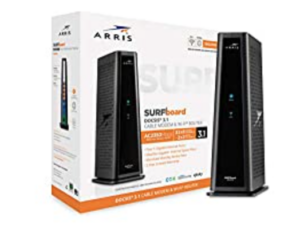Best Modems for Gigabit Internet 2024
Our expert guide to the best gigabit modems
Dec 20, 2023 | Share
Equipment Guides, Internet Speed Guides
-
Best overallMotorola MB8600
- $167.46
- (2) Gigabit Ethernet ports
- DOCSIS 3.1 (2x2)
- DOCSIS 3.0 (32x8)
-
Best valueARRIS SURFboard SB8200
- $138.98
- (2) Gigabit Ethernet ports
- DOCSIS 3.1 (2x2)
- DOCSIS 3.0 (32x8)
-
Best for gamingNETGEAR Nighthawk CM2000
- $295.00
- (1) 2.5 GbE port
- DOCSIS 3.1 (2x2)
- DOCSIS 3.0 (32x8)
-
Best for businessNETGEAR Nighthawk CM1200
- $211.83
- (4) Gigabit Ethernet ports
- DOCSIS 3.1 (2x2)
- DOCSIS 3.0 (32x8)
-
Best with Wi-FiARRIS SURFboard SBG8300
- $189.99
- (4) Gigabit Ethernet ports
- DOCSIS 3.1 (2x2)
- DOCSIS 3.0 (32x8)
Amazon.com prices (as of 12/20/23 09:42 MST). Read full disclaimer.
Our pick: Which gigabit modem is best?
The best gigabit modem is the Motorola MB8600. It packs four Gigabit Ethernet ports and supports DOCSIS 3.1 (2×2) and DOCSIS 3.0 (32×8) standards. It’s reasonably priced, too, compared to other gigabit modems with fewer features.
Looking for a modem/router combo (wireless gateway)?
The ARRIS SURFboard SBG8300 listed below is a wireless gateway. However, be sure to check out our list of the best modem/router combos for more options from ARRIS, Motorola, NETGEAR, and more. We even list our favorite gateway for DSL internet.
The 5 best modems for gigabit internet
- Best overall: Motorola MB8600
- Best value: ARRIS SURFboard SB8200
- Best for gaming: NETGEAR Nighthawk CM2000
- Best for business: NETGEAR Nighthawk CM1200
- Best with Wi-Fi: ARRIS SURFboard SBG8300
Best modems for gigabit internet
| Model | Image | Price* | Max download speed | Get it | |
|---|---|---|---|---|---|
| Best overall | Motorola MB8600 |  | $167.46 | 3.8 Gbps | View on Amazon |
| Best value | ARRIS SURFboard SB8200 |  | $138.98 | 2 Gbps | View on Amazon |
| Best for gaming | NETGEAR Nighthawk CM2000 |  | $295.00 | 2.5 Gbps | View on Amazon |
| Best for business | NETGEAR Nighthawk CM1200 |  | $211.83 | 2 Gbps | View on Amazon |
| Best with Wi-Fi | ARRIS SURFboard SBG8300 |  | $189.99 | 1.7 Gbps | View on Amazon |
Amazon.com prices (as of 12/20/23 09:42 MST). Read full disclaimer.
What should you look for in a modem for gigabit internet?
When shopping for a new modem for gigabit internet, you first need to determine its compatibility with your current internet connection. Check the tech specs or call your provider to make sure the modem works with your internet plan.
Second, make sure that it has a good warranty. You should be able to register the modem with the manufacturer and call customer support if there’s ever a glitch in the hardware.
Finally, get a modem with multiple Ethernet ports. You can link Ethernet ports together to create one super-fast wired connection or use them separately if your internet plan supports multiple IP addresses.
Best overall—Motorola MB8600
$167.46
Specs:
- DOCSIS 3.1 (2×2)
- DOCSIS 3.0 (32×8)
- 3.8 Gbps max downstream
- 1 Gbps max upstream
- (1) Gigabit Ethernet port
- (3) masked Gigabit Ethernet ports
- Compatible providers: Xfinity, Cox
Amazon.com price (as of 12/20/23 09:42 MST). Read full disclaimer.
The Motorola MB8600 certainly has some impressive numbers behind it. Four Gigabit Ethernet ports? Maximum 3.8 Gbps download speeds? Way cool.
But there’s something you should know. Most cable internet providers can barely break the 1 Gbps (or 1,000 Mbps) mark at this point, so claims of 3.8 Gbps download capacity are more aspirational than anything—it’ll take some time before a cable internet provider will be capable of breaking through Xfinity’s current 1.2 Gbps cap.
As for the four Gigabit Ethernet ports, you can use only one right out of the box—the other three are masked and unnecessary—at least, for now. When a 2 Gbps connection becomes available, you can link the first and second Ethernet ports to create a 2 Gbps connection to a compatible router. All four ports linked together total 4 Gbps.
You can also use these ports separately if your internet plan supports multiple IP addresses. For example, you may run a business from your home and have a web server set up in your office. Your home network can use one Ethernet port, while your server can use another port.
Overall, it’s these extras that make us consider Motorola’s MB8600 one of the best gigabit modems around.
 Pros:
Pros:
- Four Gigabit Ethernet ports
- Excellent Broadcom chipset
 Cons:
Cons:
- Bulky design
- Limited compatibility with providers
Best value—ARRIS SURFboard SB8200
$138.98
Specs:
- DOCSIS 3.1 (2×2)
- DOCSIS 3.0 (32×8)
- 2 Gbps max downstream
- 1 Gbps max upstream
- (2) Gigabit Ethernet ports
- Compatible providers: Xfinity, Cox, Spectrum
Amazon.com price (as of 12/20/23 09:42 MST). Read full disclaimer.
The ARRIS SURFboard SB8200 boasts a utilitarian look, with its boxy shape and straightforward color schemes (you can get it in white or black). Behind the blinking LED lights and ventilated chassis, there are 3 GB of RAM, 128 MB/16 MB of flash memory, and 32 downstream and 8 upstream channels.
The SB8200 includes two Gigabit Ethernet ports you can link together for a 2 Gbps connection to a compatible device. That’s the most you’ll see out of this modem, even though the DOCSIS 3.1 specs sing a tune of 10 Gbps. You can use these two ports separately, too, if your internet plan supports multiple IP addresses.
You can easily set up this modem using the ARRIS SURFboard Central app. Of course, there’s no Wi-Fi to configure, but the app will pair your mobile device to the modem, so you can cater the device to your specified internet provider.
 Pros:
Pros:
- No more Puma 6 chipset
- Multiple color options
 Cons:
Cons:
- Fewer Ethernet ports
- Limited compatibility with cable providers
Best for gaming—NETGEAR Nighthawk CM2000
$295.00
Specs:
- DOCSIS 3.1 2×2
- DOCSIS 3.0 32×8
- 2.5 Gbps max downstream
- 2.5 Gbps max upstream
- (1) 2.5 Gb Ethernet port
- Compatible providers: Xfinity, Spectrum, Cox
Amazon.com price (as of 12/20/23 09:42 MST).Read full disclaimer.
The CM2000 is the only modem on our list with one Ethernet port. It’s a great exception to our suggestion to pick a modem with more than one. Its single port speeds along at a hefty 2.5 Gbps, but you need a compatible router that can support that connection—otherwise, you’ll see just 1 Gbps (or less).
The good news is that the fastest cable internet plan available is only 1.2 Gbps, so you’re essentially investing in the (seemingly far distant) future. NETGEAR boasts a maximum download speed of 10 Gbps, but you’ll never see it thanks to the single 2.5 Gbps port.
Putting aside the one-port bottleneck, we chose this modem for gaming due to the aesthetics—it just looks like it belongs next to your gaming rig. Sure, the CM2000 is a little pricey, but NETGEAR is a solid brand we love and trust, so it’s definitely worth the investment.
Worried about internet costs?
Be sure to read our guide on how to find more affordable Wi-Fi. We list programs offered by the government and internet providers that could reduce your monthly bill.
![]() Pros:
Pros:
- Fast 2.5 Gbps port
- Compatibility with all major cable internet providers
![]() Cons:
Cons:
- Just one Ethernet port
Best for business—NETGEAR Nighthawk CM1200
$211.83
Specs:
- DOCSIS 3.1 2×2
- DOCSIS 3.0 32×8
- 2 Gbps max downstream
- 1 Gbps max upstream
- (4) Gigabit Ethernet ports
- Compatible providers: Xfinity, Spectrum, Cox, Comcast Business
Amazon.com price (as of 12/20/23 09:42 MST). Read full disclaimer.
The CM1200 is great for businesses that have more than one IP address. NETGEAR even lists Comcast Business as a compatible service (along with Xfinity, Spectrum, and Cox).
The secret to the CM1200’s success lies in its four Gigabit Ethernet ports. Each can support an IP address if your business account allows it, so any business can have up to four separate networks accessing this single modem.
However, that means the maximum download speed for each connection will be 1 Gbps. Technically, you can link the first two Ethernet ports for a 2 Gbps connection to a compatible device, but the remaining two connections will be 1 Gbps each. Ignore all the DOCSIS jargon about reaching 10 Gbps—that kind of output isn’t possible on this modem.
It’s rare to meet someone who still uses a landline phone these days, but NETGEAR has you covered if you do need a modem that can work with bundled phone services (i.e., an internet package that also provides support for phone lines). NETGEAR’s slightly more expensive Nighthawk CM1150V is basically the CM1200 but with voice/phone support included.
 Pros:
Pros:
- Slick, unobtrusive appearance
- Easy setup
- Lots of Ethernet ports
 Cons:
Cons:
- Costs more for average features
Best with Wi-Fi—ARRIS SURFboard SBG8300
$189.99
Specs:
- DOCSIS 3.1 (2×2)
- DOCSIS 3.0 (32×8)
- 1.7 Gbps max downstream
- 1 Gbps max upstream
- (4) Gigabit Ethernet ports
- AC2350 Wi-Fi
- Compatible providers: Xfinity, Cox
Amazon.com price (as of 12/20/23 09:42 MST).Read full disclaimer.
The ARRIS SURFboard SBG8300 is a wireless gateway, not a standard modem. That means it combines the functions of a modem with a Wi-Fi 5 router in one unit, saving you space.
The Wi-Fi portion provides a maximum throughput of 2,350 Mbps. In other words, the 5 GHz band has a maximum speed of 1,733 Mbps (4 x 433 Mbps) while the 2.4 GHz band has a maximum speed of 600 Mbps (3 x 200 Mbps). This is where the maximum download speed gets tricky.
The DOCSIS 3.1 spec says this gateway can reach 10 Gbps. However, the maximum speed this gateway can deliver over Wi-Fi is 1.7 Gbps. The maximum speed you’ll get from a single wired connection is 1 Gbps. ARRIS boasts a 4 Gbps wired connection, but you can’t link the four Ethernet ports.
The SBG8300 is approved to work with Xfinity and Cox internet plans. But it won’t work with Verizon, AT&T, or CenturyLink internet plans. ARRIS is waiting on approval from Spectrum and other cable companies, so make sure to check with your ISP if this will be compatible before spending your hard-earned cash.
 Pros:
Pros:
- Offers convenient network management
- Saves on space
 Cons:
Cons:
- High cost
- Limited compatibility with ISPs
- Fewer security options
Gigabit modem specs and features
Here we’ll dig deeper into the specs and features you should consider when you’re shopping for a new gigabit modem.
DOCSIS compatibility
If you’ve been nodding your head politely and pretending to understand the whole DOCSIS thing but still haven’t quite figured it out, don’t worry—it took us a while to figure it out too.
The term DOCSIS stands for Data Over Cable Service Interface Specifications. It’s a standard that defines how cable internet providers can transmit data over existing lines originally meant for cable TV.
DOCSIS has evolved quite a bit since it first launched in 1997. DOCSIS 3.1, the latest version of this technology, came out in October 2013. Cable companies were excited because it opened the possibility for achieving multi-gigabit speeds as fast as 10 Gbps (10,000 Mbps) over cable lines. In technical terms, experts would describe this as “insanely super-duper fast.”
DOCSIS 3.1
Cable internet providers haven’t hit 10 Gbps just yet—most companies offer residential cable internet plans up to 1 Gbps—up to 1.2 Gbps if you have Xfinity.
The 1 Gbps cable internet cap is mostly due to the following:
- Most home networks still use Ethernet ports that support up to 1 Gbps.
- Not everyone has adapted to DOCSIS 3.1.
- Cable internet providers need to expand to support the higher bandwidth.
Overall, switching over to DOCSIS 3.1 is a lot more affordable on the provider’s end than building a new network of fiber-optic lines—it’s like installing a faster engine in a car versus building a network of teleporters from scratch.
Sooner or later, faster speeds will be an option, and when that happens, you’ll be happy you got a gigabit cable modem compatible with DOCSIS 3.1.
DOCSIS 3.0
Most modems nowadays meet the standards of DOCSIS 3.0, and the higher-end ones can deliver 1 Gbps download speeds, according to the organization behind the DOCSIS protocol.
DOCSIS 3.0 came out in August 2006, but it’s still widely in use and far more common than DOCSIS 3.1. If it doesn’t work out between you and your shiny new gigabit plan, you’ll still want a cable gigabit modem that’s backward compatible for DOCSIS 3.0.
As you’re eyeballing options and thinking about which is the best modem for gigabit internet, look for a modem that works under both standards. Ideally, you want one that can deliver 32 downstream and 8 upstream channels in DOCSIS 3.0, letting you hit 1 Gbps speeds (or something close) even under that standard.
Not sure about the ins and outs of Wi-Fi speed?
Don’t worry. We break it all down with our handy guide to internet speed to keep you informed.
Gigabit Ethernet ports
Here’s a little secret modem manufacturers typically fail to disclose: your modem’s full potential is probably bottlenecked by its Ethernet port(s).
You’ve probably spied cable modems advertising DOCSIS 3.1 and 10 Gbps speeds. Woohoo! Fast, right? Problem is, modems typically have a Gigabit Ethernet port, or a 2.5 GbE port (short for 2.5 Gbps Ethernet) at most. That’s far slower than the boasted 10 Gbps maximum, so you want a modem with multiple Ethernet ports that support link aggregation.
For example, you may find a modem with four Gigabit Ethernet ports. In some cases, you can link only two, to create a 2 Gbps connection to a compatible device. In other cases, you can link all four together for a 4 Gbps connection. Not too shabby, right?
But you’re still not getting 10 Gbps with those configurations. Your best bet is to get a modem with a 10 GbE port, or a modem with four 2 GbE ports. But since these configurations still remain in the realm of science-fiction, you’ll have to suffice with modems with four or fewer Gigabit Ethernet ports.
The bottom line: the more Gigabit Ethernet ports you can link together, the merrier. But, in reality, it’s all irrelevant since the fastest cable internet plan remains locked at 1.2 Gbps.
Shopping around for new internet?
Enter your zip code below to see which providers are available in your area.
Our verdict: A gigabit modem is worth it
The Motorola MB8600 is clearly the best modem for gigabit internet currently on the market. It’s compatible with DOCSIS 3.1 and DOCSIS 3.0, it has four Gigabit Ethernet ports for advanced uses, and it’s a decent price compared with similar modems.
FAQ about gigabit modems
What is the best gigabit modem?
The Motorola MB8600 is the best modem for cable internet speeds of 1,000 Mbps or faster. It’s compatible with DOCSIS 3.1 standards, has four Gigabit Ethernet ports for link aggregation, and delivers 32×8 channel bonding if used on a DOCSIS 3.0 network. It’s the best bang for your gigabucks.
What gigabit modems are compatible with Xfinity?
These modems are all compatible with Xfinity’s Gigabit Extra (1.2 Gbps) and slower cable internet plans:
- Motorola MB8600
- ARRIS SURFboard SB8200
- NETGEAR Nighthawk CM2000
- NETGEAR CM1000
- NETGEAR CM1200
- ARRIS SURFboard SBG8300
These modems are not compatible with Xfinity’s Gigabit Pro and Gigabit X3 fiber-to-the-home plans.
What modem do I need for gigabit internet?
To get the best out of your gigabit plan, you’ll need a cable modem that’s compatible with DOCSIS 3.0. This standard supports up to 1,000 Mbps, but your download speed will depend on the number of download channels the modem can support. We suggest a modem with a 32×8 configuration.
If you want to future-proof your internet connection, get a modem based on DOCSIS 3.1, the latest version of DOCSIS cable company standards. It supports download speeds up to 10 Gbps, but it’ll need enough Ethernet ports to support that maximum speed.
Do I need DOCSIS 3.1 for gigabit internet?
You don’t technically need DOCSIS 3.1 to achieve 1 Gbps (1,000 Mbps) download speeds—you can achieve those speeds with a DOCSIS 3.0 modem. But a modem compatible with DOCSIS 3.1 will ensure that you reach 1 Gbps speeds and beyond.
Disclaimer
Product prices and availability are accurate as of the date/time indicated and are subject to change. Any price and availability information displayed on Amazon.com at the time of purchase will apply to the purchase of this product. HighSpeedInternet.com utilizes paid Amazon links.
CERTAIN CONTENT THAT APPEARS ON THIS SITE COMES FROM AMAZON. THIS CONTENT IS PROVIDED ‘AS IS’ AND IS SUBJECT TO CHANGE OR REMOVAL AT ANY TIME.
Author - Peter Holslin
Peter Holslin has more than a decade of experience working as a writer and freelance journalist. He graduated with a BA in liberal arts and journalism from New York City’s The New School University in 2008 and went on to contribute to publications like Rolling Stone, VICE, BuzzFeed, and countless others. At HighSpeedInternet.com, he focuses on covering 5G, nerding out about frequency bands and virtual RAN, and producing reviews on emerging services like 5G home internet. He also writes about internet providers and packages, hotspots, VPNs, and Wi-Fi troubleshooting.
Editor - Cara Haynes
Cara Haynes has been editing and writing in the digital space for seven years, and she's edited all things internet for HighSpeedInternet.com for five years. She graduated with a BA in English and a minor in editing from Brigham Young University. When she's not editing, she makes tech accessible through her freelance writing for brands like Pluralsight. She believes no one should feel lost in internet land and that a good internet connection significantly extends your life span.










